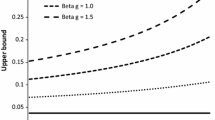Abstract
In this short note we prove a conjecture posed in Cui et al. (Math Finance 22:346–378, 2012): Dynamic mean–variance problems in arbitrage-free, complete financial markets do not allow free cash flows. Moreover, we show by investigating a benchmark problem that this effect is due to the performance criterion and not due to the time inconsistency of the strategy.
Similar content being viewed by others
References
Basak S, Chabakauri G (2010) Dynamic mean–variance asset allocation. Rev Finance 23:2970–3016
Bäuerle N, Müller A (2006) Stochastic orders and risk measures: consistency and bounds. Insur Math Econ 38:132–148
Bäuerle N, Rieder U (2011) Markov decision processes with applications to finance. Springer, Berlin
Bäuerle N, Urban SP, Veraart LAM (2012) The relaxed investor with partial information. SIAM J Financ Math 3:304–327
Bernard C, Chen JS, Vanduffel S (2013) Rationalizing investors choice. arXiv:1302.4679
Černý A, Kallsen J (2007) On the structure of general mean–variance hedging strategies. Ann Probab 35:1479–1531
Cui X, Li D, Wang S, Zhu S (2012) Better than dynamic mean–variance: time inconsistency and free cash flow stream. Math. Finance 22:346–378
Dang DM, Forsyth PA (2013) Better than pre-commitment mean-variance portfolio allocation strategies: a semi-self-financing Hamilton–Jacobi–Bellman equation approach. http://ssrn.com/abstract=2368558
Korn R (1997) Optimal portfolios. Stochastic models for optimal investment and risk management in continuous time. World Scientific, Singapore
Korn R, Trautmann S (1995) Continuous-time portfolio optimization under terminal wealth constraints, Zeitschrift für operations research. Math Methods Oper Res 42:69–92
Kryger EM, Stefensen M (2010) Some solvable portfolio problems with quadratic and collective objectives. http://ssrn.com/abstract=1577265
Li D, Ng WL (2000) Optimal dynamic portfolio selection: multiperiod mean–variance formulation. Math Finance 10:387–406
Shalit H, Yitzhaki S (1984) Mean–Gini, portfolio theory, and the pricing of risky assets. J Finance 39:1449–1468
Zhou XY, Li D (2000) Continuous-time mean–variance portfolio selection: a stochastic LQ framework. Appl Math Optim 42:19–33
Author information
Authors and Affiliations
Corresponding author
Rights and permissions
About this article
Cite this article
Bäuerle, N., Grether, S. Complete markets do not allow free cash flow streams. Math Meth Oper Res 81, 137–146 (2015). https://doi.org/10.1007/s00186-014-0489-2
Received:
Accepted:
Published:
Issue Date:
DOI: https://doi.org/10.1007/s00186-014-0489-2




